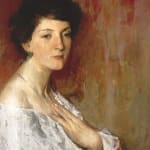Charles Webster Hawthorne 1872-1930
Framed dimensions: 24 3/8 x 21 1/2 inches
Like his mentor the great American Impressionist William Merritt Chase, Charles Webster Hawthorne was equally admired in his own day as both a talented painter and a highly influential instructor. Hawthorne first studied with Chase at his Shinnecock Summer School of Art, which was specifically dedicated to open-air landscape painting. Not only did Hawthorne quickly absorb all the principles of Chase’s instruction, but he also became determined to found his own school based on the same model. In 1899 Hawthorne discovered the small fishing village of Provincetown on the furthermost tip of Cape Cod, and after purchasing a large house on Miller Hill, he opened the Cape Cod School of Art, which proved to be an immediate success.
While Hawthorne’s own approach as a teacher owed much to Chase, he developed a distinctly unique painting style and teaching method that defies easy categorization. He was greatly impressed with the work of Franz Hals, which he was exposed to during his trip to Holland in the summer of 1898. Hawthorne was particularly struck by Hals’ Regentesses of the Old Men’s Almhouse, and from this work he absorbed a deep appreciation for the power of human expression and an economy of technique. Hawthorne applied these lessons to his own realistic portraits of Provincetown fishermen and their families; these works have a somber, almost melancholy quality to them, and they reveal a sense of the vulnerability of the human condition.
Stylistically, Hawthorne maintained a life-long commitment to the importance of color. “Beauty in art,” he said, “is the delicious notes of color one against the other.” Of equal importance to him was capturing the effects of light. He told his students: “Everything in painting is a matter of silhouettes. Hold light against shadow, not light against light.” He developed a particular technique of layering glazes and texturing the surface of his paintings, which heightens the relationship between the colors and creates a light effect that seems to emanate from within the painting. These stylistic techniques in combination with his straightforward compositions of one or more figures shown at close range create the hallmarks of Hawthorne’s best paintings.
Hawthorne and his wife Ethel’s 1905-1907 trip to Italy did not result in a drastic impact on his artistic style. Nonetheless, it proved to be a transformative and enlightening voyage. The extensive trip was financed by collectors who paid in advance for a painting to be produced abroad. On the trip, Hawthorne explored the work of old masters and was struck particularly by the paintings of Titian, which to Hawthorne, demonstrated the master’s true adoration for the act of painting itself through his handling of paint and color. Where Titian’s paintings inspired Hawthorne, Velázquez’s paintings more directly influenced him. Both Hawthorne and Velázquez “[portrayed] the dignity they found in ordinary people”, a quality which defined Hawthorne’s art from Provincetown to Holland to Venice (Charles Webster Hawthorne: Paintings & Watercolors, 25). Hawthorne’s time spent immersed in the ins and outs of the art of a bygone era gave him new ideas and a new outlook on life and art. Even more so than before, Hawthorne concluded that “his mission as an artist was to ‘make a big thing out of a little subject’” (Paintings & Watercolors, 23).
Hawthorne’s In Venice, a deceptively straightforward portrait of a girl painted in 1907, evokes a deep sense of contemplation and intelligence. Hawthorne’s son, Joseph, remembered that his father always completed the eyes first when painting. Whether or not this was the case for In Venice, the sitter’s eyes are incredibly soulful and seemingly alive. Critics may have “feared the note of humanity” in Hawthorne’s art, but Hawthorne himself certainly did not shy away from capturing the complex plethora of emotions at work in every individual regardless of background or gender (Charles W. Hawthorne: An American Figure Painter 20). Seated against an abstract background, the girl’s deep brown hair is like a dark cloud against the striking patch of red in the upper left, recalling Hawthorne’s commitment to capturing the harmonies between one color and its neighbor. Like the mysterious and fleeting thoughts behind the girl’s eyes, she too seems to fade away: her white dress is ghostly in the light, disappearing neatly at the bottom of the canvas. Characteristic to Hawthorne’s Italian years are a firmer sense of form and a less pronounced manifestation of brushstrokes, both of which are evident in In Venice. In a marriage of style and emotional character, In Venice proves a representative painting for Hawthorne, particularly so of his Italian years.
Provenance
Collection of Edwin Dickinson;Babcock Galleries, New York;
Private collection, Medford, Oregon;
By descent in the family until 2024
Please join our mailing list
* denotes required fields
We will process the personal data you have supplied in accordance with our privacy policy (available on request). You can unsubscribe or change your preferences at any time by clicking the link in our emails.



